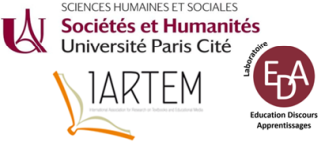One of the mysteries teachers encounter is what happens in students' minds when they stare at a map and struggle to solve a 'simple' task. While there is no shortage of literature advising teachers on the best methods to teach map skills and numerous tests support their assessment of map skills, what students do during task processing remains a black box. This paper aims to sneak peek into the black box using eye-tracking during map decoding task processing.
Research in geography education looks back on a considerable tradition and, as Hüttermann (2007) argues, geography educators repeatedly stressed the differences between continuous text of a novel and discontinuous text, such as pictures, graphs, and maps. Reading a map is fundamentally different from reading a book, as it lacks a clear starting point (left top in English) and a direction of reading (from the left to the write, from the top to the bottom, in English). Map reading offers the luxury of starting at any represented content detail or systematically going through the title, legend, scale, and orientation. Still, reading a text or a map is a similar cognitive challenge as both formats require knowledge of the codes. What letters, words, and sentences are to the continuous text, symbols, colors, and scale are to the map. Thus, to a certain extent, acquiring the ability to read a continuous text and a map retains a certain similarity. Therefore, Hemmer et al. (2010) heavily relied on the PISA Model of Reading Literacy (Baumert et al., 2001) when they developed the Map Skills Model; however, given that maps combine text with visual information, they also considered the Integrated Text-Image-Understanding Model (Schnotz & Bannert, 2003). The Map Skills Model constitutes the main framework of reference for this paper. Building upon previous research on map decoding, this paper explores what students do during task processing using eye-tracking. Therefore, its aim is twofold. Beyond the specific findings, the present study also aims to reflect on the method and its potential for further development for future studies.
Eye-tracking served to collect data on students' strategies when solving tasks requiring map decoding. The test persons wore a portable eye tracker while observing the stimuli on a laptop screen. Following an initial exercise to get acquainted with eye-tracking and answering any open questions, a welcoming slide announced the test's commencement, followed by five slides. Each slide entailed a stimulus consisting of the task and a thematic map of Australia. Following data collection, time stamps helped determine the task processing duration. Subsequent close watching allowed for the determination of the eye movement trajectory. The final sequences are the result of compared codes by two independent researchers.
Following ethics clearance, two geography teachers facilitated access to seventh- (age 13-14 years) and tenth-graders (aged 16-17 years). The study took place in the Hungarian city of Szeged. This study's sample consisted of two students and remains exemplary. It presents the findings on a low-achieving seventh-grader and a high-achieving tenth-grader based on their teachers' feedback on their map skills.
The preliminary results uncovered several similarities and differences between the novice and the expert student. Data processing is currently still in progress.
Baumert, J., Klieme, E., Neubrand, M., Prenzel, M., Schiefele, U., Schneider, W., Stanat, P., Tillmann, K. J., & Weiss, M. (eds.) (2001). PISA 2000. Basiskompetenzen von Schülerinnen und Schülern im internationalen Vergleich (PISA 2000. Students' Basic Concepts in International Comparison). Leske und Budrich.
Hemmer, I., Hemmer, M., Hüttermann, A., & Ullrich, M. (2010). Kartenauswertungs-kompetenz. Theoretische Grundlagen und erste Überlegungen zu einem Kompetenzstrukturmodell (Map Interpretation Skills. Theoretical Framework and First Thought Concerning a Competencies Model). Geographie und ihre Didaktik | Journal of Geography Education, 38(3), 158–171.
Hüttermann, A. (2007). Karten als „nicht-kontinuierliche Texte“ (Maps as ‘Discontinuous Text'). In M. Geiger & A. Hüttermann (Hg.), Raum und Erkenntnis (Space and Insight) (S. 118–123). Aulis-Verlag Deubner.
Schnotz, W., & Bannert, M. (2003). Construction and Interference in Learning from Multiple Representations. Learning and Instruction, 13(2), 141–156.

 PDF version
PDF version
